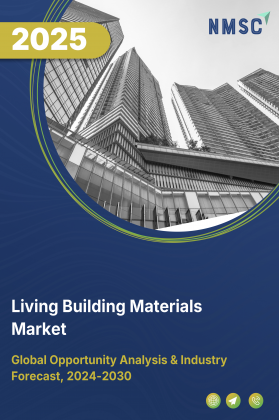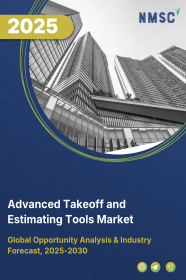
Living Building Materials Market by Material Type (Wood-Based Products, Agricultural & Plant-Based Materials, and Others), by Construction Type (New Construction, Renovation and Retrofit), by Application (Structural Applications, Insulation & Envelope and Others), by Distribution Channel (Direct Sales, Specialized Green Distributors and Others), and by End User (Residential, Commercial, and Others) – Global Opportunity Analysis and Industry Forecast, 2025 – 2030.
Industry Overview
The global Living Building Materials Market size was valued at USD 33.85 billion in 2024 and is estimated to reach USD 42.68 billion in 2025 and is predicted to reach USD 136.08 billion by 2030 with a CAGR of 21.6% from 2025-2030.
Living building materials also known as bio-based building materials market is experiencing robust growth driven by rapid urbanization, expanding construction activities, and rising demand for sustainable construction. Increasing urban populations are fueling the need for new residential, commercial, and infrastructure development, which in turn accelerates the adoption of eco-friendly, renewable materials. Builders and developers are shifting towards bio-based products to reduce carbon footprints and meet stricter green building regulations.
Despite challenges like the high cost of specialized expertise required for handling these materials, innovations such as the integration of bio-based organisms offer promising future opportunities by enhancing material performance and sustainability. Overall, growing environmental awareness and government initiatives promoting green construction are key factors propelling significant living building materials market expansion globally.
Rising Urbanization Drives the Market Growth
Rapid urbanization is a major driver of the living building materials market growth as it fuels increased construction activities in cities around the world. According to the World Bank in 2024, the urban population accounts for 37% of India’s total population and 84% in the United States, highlighting significant urban concentration in these key markets.
As more people move to urban areas, the demand for residential, commercial, and infrastructure development rises sharply. This growth accelerates the need for sustainable and eco-friendly building materials. Bio-based building materials, derived from renewable resources, provide an environmentally responsible alternative to conventional materials by lowering carbon footprints and enhancing energy efficiency. Furthermore, government initiatives and regulations promoting green construction amplify this trend, collectively driving robust growth in the market.
Expanding Construction Industry Boosts the Market Expansion
The expanding construction industry is a key driver of the living building materials market demand. As global infrastructure development and urbanization accelerate, there is a rising need for new residential, commercial, and industrial buildings. This growth in construction activities increases the need for sustainable and eco-friendly materials to meet environmental regulations and consumer preferences.
Bio-based building materials, made from renewable and natural resources, are increasingly adopted to reduce carbon emissions and support green building initiatives. The continuous rise in construction projects worldwide is therefore propelling the demand for these sustainable materials, driving significant market growth.
Rising Demand of Sustainable Construction Fuels the Market Demand
The rising demand for sustainable construction is a major driver of the market. With increasing awareness about environmental issues and the impact of traditional construction practices, builders and developers are shifting towards eco-friendly solutions. Sustainable construction focuses on minimizing carbon footprints, conserving natural resources, and improving energy efficiency in buildings.
Bio-based building materials, made from renewable and biodegradable resources, perfectly align with these goals. As governments enforce stricter green building regulations and consumers prefer environmentally responsible choices, the demand for bio-based materials continues to grow, significantly boosting the market.
High Cost of Specialized Expertise Hinders the Market Growth
The high cost of specialized expertise is a significant restraint on the growth of the market. Implementing bio-based materials often requires skilled professionals who understand their unique properties, installation techniques, and maintenance requirements. However, the limited availability of such trained experts increases project costs and complexity. This can discourage builders and developers from adopting bio-based solutions, especially in markets where cost sensitivity is high. As a result, the need for specialized knowledge and the associated expenses slows down the wider acceptance and growth of the market.
Integration of Bio-Based Organisms in Building Materials Creates Future Opportunities for the Market
The integration of bio-based organisms, such as bacteria, algae, and fungi, into building materials presents promising future opportunities for the market. These innovative materials can offer self-healing properties, improved insulation, and enhanced sustainability by utilizing living organisms to strengthen or repair structures naturally.
As research and development in this area advance, the adoption of such cutting-edge bio-based solutions is expected to grow, providing new applications and improved performance in construction. This emerging trend opens up significant potential for industry expansion by addressing environmental concerns while delivering innovative building technologies.
Market Segmentations and Scope of the Study
The living building materials market report is divided on the basis of material type, construction type, application, distribution channel, and end user. On the basis of material type, the market is grouped into wood-based products, agricultural & plant-based materials, bio-polymers & bioplastics, natural fiber, mycelium & algae-based living materials, insulation-specific bio-materials, bio-concrete, and others. On the basis of construction type, the market is categorized into new construction and renovation & retrofit. On the basis of application, the market is grouped into structural applications, insulation & envelope, cladding, profiles & finishes, pipes & functional components, smart materials, flooring, wall panels, and others. On the basis of distribution channel, the market is categorized into direct sales, specialized green distributors, architects and specifiers, online/e-commerce, and bulk industrial suppliers. On the basis of end user, the market is grouped into residential, commercial, industrial & infrastructure, and landscape and urban. Regional breakdown and analysis of each of the aforesaid segments includes regions comprising of Asia-Pacific, North America, Europe, and RoW.
Geographical Analysis
Strict environmental regulations and green building standards in North America are a major driver for the living building materials market share. Governments and industry bodies are increasingly enforcing policies that promote sustainability, energy efficiency, and reduced carbon emissions in construction projects.
Programs like LEED (Leadership in Energy and Environmental Design) and incentives for green building practices encourage developers to adopt eco-friendly materials. As a result, bio-based building materials, known for their renewable and low-impact nature, are in high demand to comply with these regulations, driving significant market growth across the region.
Europe’s strong emphasis on sustainability and the circular economy is a key driver of the market. Governments and regulatory bodies across the region are implementing strict policies and incentives to reduce waste, lower carbon emissions, and promote the use of renewable resources in construction.
This focus encourages architects, builders, and developers to increasingly adopt bio-based materials that align with these environmental goals. The European Union’s Green Deal and related initiatives further accelerate demand, making sustainability a powerful catalyst for market growth in Europe.
The rapid urbanization and ongoing infrastructure development across the Asia Pacific region are major drivers for the market. Countries like China, India, and Southeast Asian nations are experiencing fast population growth and expanding cities, leading to increased construction activities.
Alongside this growth, there is a rising awareness and government push for sustainable building practices to reduce environmental impact. This combination of booming construction demand and growing sustainability focus is driving strong adoption of bio-based building materials throughout the Asia Pacific market.
The increasing focus on reducing energy consumption and lowering greenhouse gas emissions is driving the demand for energy-efficient buildings in the Rest of the World. Rising energy costs and growing environmental awareness encourage developers and homeowners to seek construction materials that improve insulation and thermal performance.
Bio-based building materials, known for their natural insulating properties and sustainability, are becoming popular choices to meet these energy efficiency goals. This trend is accelerating the adoption of bio-based materials in residential and commercial construction, thus fueling significant growth in the market across emerging and developing regions.
Strategic Innovations Adopted by Key Players
Key players in the living building materials industry are accelerating global expansion through upscale brand launches, service diversification, and strategic partnerships. For example, Seratech unveiled progress on its carbon-neutral brick prototype, developed using captured industrial CO₂ to replace traditional cement and clay inputs.
The company has been conducting live technology demonstrations and engaging directly with concrete and brick manufacturers to explore commercial integration. Positioned as an upstream decarbonization solution, Seratech’s innovation targets large-scale displacement of high-emission materials, offering the potential for substantial carbon footprint reductions if industry adoption accelerates.
Key Benefits
-
The report provides quantitative analysis and estimations of the sector from 2025 to 2030, which assists in identifying the prevailing market opportunities.
-
The study comprises a deep-dive analysis of the current and future living building materials market trends to depict prevalent investment pockets in the sector.
-
Information related to key drivers, restraints, and opportunities and their impact on the market is provided in the report.
-
Competitive analysis of the players, along with their market share is provided in the report.
-
SWOT analysis and Porters Five Forces model is elaborated in the study.
-
Value chain analysis in the market study provides a clear picture of roles of stakeholders.
Living Building Materials Market Key Segments
By Material Type
-
Wood-Based Products
-
Agricultural & Plant-Based Materials
-
Bio-Polymers & Bioplastics
-
Natural Fiber
-
Mycelium & Algae-Based Living Materials
-
Insulation-Specific Bio-Materials
-
Bio-Concrete
-
Others
By Construction Type
-
New Construction
-
Renovation and retrofit
By Application
-
Structural Applications
-
Insulation & Envelope
-
Cladding, Profiles & Finishes
-
Pipes & Functional Components
-
Smart Materials
-
Flooring
-
Wall Panels
-
Others
By Distribution Channel
-
Direct Sales
-
Specialized Green Distributors
-
Architects & Specifiers
-
Online/E-commerce
-
Bulk Industrial Suppliers
By End User
-
Residential
-
Commercial
-
Industrial & Infrastructure
-
Landscape & Urban
By Region
-
North America
-
The U.S.
-
Canada
-
Mexico
-
-
Europe
-
The UK
-
Germany
-
France
-
Italy
-
Spain
-
Denmark
-
Netherlands
-
Finland
-
Sweden
-
Norway
-
Russia
-
Rest of Europe
-
-
Asia-Pacific
-
China
-
Japan
-
India
-
South Korea
-
Australia
-
Indonesia
-
Singapore
-
Taiwan
-
Thailand
-
Rest of Asia-Pacific
-
-
RoW
-
Latin America
-
Middle East
-
Africa
-
Key Players
-
Sould
-
Magicrete
-
Alcen industries
-
American Lime Technology
-
Hempitecture Inc.
-
Hemp Block
-
Schlamann KG
-
Sika AG
-
Basilisk
-
Dun argo hemp group
-
Seratech
-
Americhanvre
-
Hempcrete Natural Building
-
Carmeuse
REPORT SCOPE AND SEGMENTATION:
|
Parameters |
Details |
|
Market Size in 2025 |
USD 42.68 Billion |
|
Revenue Forecast in 2030 |
USD 136.08 Billion |
|
Growth Rate |
CAGR of 21.6% from 2025 to 2030 |
|
Analysis Period |
2025–2030 |
|
Base Year Considered |
2024 |
|
Forecast Period |
2025–2030 |
|
Market Size Estimation |
Billion (USD) |
|
Growth Factors |
|
|
Countries Covered |
28 |
|
Companies Profiled |
15 |
|
Market Share |
Available for 10 companies |
|
Customization Scope |
Free customization (equivalent up to 80 working hours of analysts) after purchase. Addition or alteration to country, regional, and segment scope. |
|
Pricing and Purchase Options |
Avail customized purchase options to meet your exact research needs. |

















 Speak to Our Analyst
Speak to Our Analyst

























